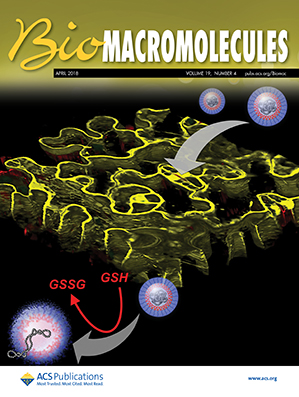用生物正交共价交联增强纤维胶原水凝胶。
IF 5.4
2区 化学
Q1 BIOCHEMISTRY & MOLECULAR BIOLOGY
引用次数: 0
摘要
生物正交共价交联稳定了I型胶原水凝胶,提高了其结构完整性,用于包封活细胞的组织工程应用。然而,交联所需的化学修饰会干扰胶原蛋白的纤维性质,导致没有纤维的无定形网络。我们展示了一种通过控制定位对胶原蛋白进行生物偶联化学的方法,使修饰后的胶原蛋白保持其自组装成纤维网络的能力,同时还显示了通过生物正交点击化学进行共价交联的官能团。胶原蛋白基质是通过连续交联过程形成的,在这个过程中,修饰的胶原蛋白首先物理组装成纤维,然后共价交联。这种方法保留了胶原蛋白的纤维结构,指导被包裹的人角膜间充质间质细胞的行为,同时通过共价交联增强纤维,增强细胞负载胶原水凝胶的稳定性,抵抗细胞诱导的收缩和酶促降解。本文章由计算机程序翻译,如有差异,请以英文原文为准。
Reinforcement of Fibrillar Collagen Hydrogels with Bioorthogonal Covalent Crosslinks
Bioorthogonal covalent crosslinking stabilizes collagen type I hydrogels, improving their structural integrity for tissue engineering applications with encapsulated living cells. The chemical modification required for crosslinking, however, interferes with the fibrillar nature of the collagen, leading instead to an amorphous network without fibers. We demonstrate an approach to perform bioconjugation chemistry on collagen with controlled localization such that the modified collagen retains its ability to self-assemble into a fibrillar network while also displaying functional groups for covalent crosslinking with bioorthogonal click chemistry. The collagen matrix is formed through a sequential crosslinking process, in which the modified collagen first physically assembles into fibers and then is covalently crosslinked. This approach preserves the fibrous architecture of the collagen, guiding the behavior of encapsulated human corneal mesenchymal stromal cells while also reinforcing fibers through covalent crosslinks, strengthening the stability of the cell-laden collagen hydrogel against cell-induced contraction and enzymatic degradation.
- Download: Download high-res image (245KB)
- Download: Download full-size image
求助全文
通过发布文献求助,成功后即可免费获取论文全文。
去求助
来源期刊

Biomacromolecules
化学-高分子科学
CiteScore
10.60
自引率
4.80%
发文量
417
审稿时长
1.6 months
期刊介绍:
Biomacromolecules is a leading forum for the dissemination of cutting-edge research at the interface of polymer science and biology. Submissions to Biomacromolecules should contain strong elements of innovation in terms of macromolecular design, synthesis and characterization, or in the application of polymer materials to biology and medicine.
Topics covered by Biomacromolecules include, but are not exclusively limited to: sustainable polymers, polymers based on natural and renewable resources, degradable polymers, polymer conjugates, polymeric drugs, polymers in biocatalysis, biomacromolecular assembly, biomimetic polymers, polymer-biomineral hybrids, biomimetic-polymer processing, polymer recycling, bioactive polymer surfaces, original polymer design for biomedical applications such as immunotherapy, drug delivery, gene delivery, antimicrobial applications, diagnostic imaging and biosensing, polymers in tissue engineering and regenerative medicine, polymeric scaffolds and hydrogels for cell culture and delivery.
 求助内容:
求助内容: 应助结果提醒方式:
应助结果提醒方式:


